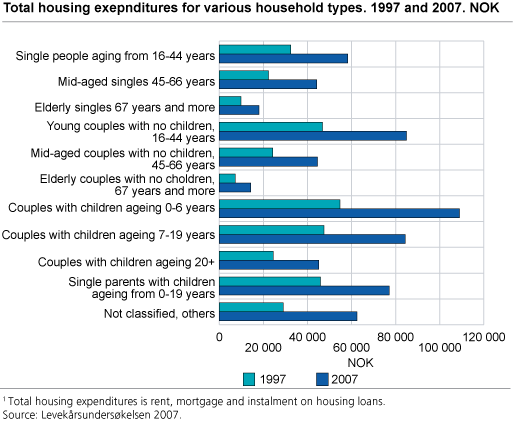Content
Published:
This is an archived release.
Young people face the highest debt growth
Housing expenditures among owners have increased considerably since 2004, as have housing loans. The increase in housing debt was largest among younger couples without children, families with children and single parents. Many younger singles have become owners.
During the period 1997-2007 the percentage of owners among one-person households below 45 years of age increased from 31 to 41 per cent. Owners are defined as both freeholders and part owners and share holders. Mot of the increase took place after 2004. There was an increase both among those below and above 30 years. The percentage of owners also increased among families with small children, from 82 per cent in 1997 to 90 per cent in 2007. Most of this increase however took place before 2004. The percentage of owners among all households did not change during these ten years.
Housing expenditures increased considerably after 2004
Four surveys of living conditions have been carried out from 1997 to 2007, in 1997, 2001, 2004 and 2007. The changes in housing economy have been the most dramatic in this ten-year period. For the population as a whole there have been only modest changes in size, standard and environment of dwellings.
The housing expenditures defined as rent, mortgage and instalment increased by 81 per cent from 1997 to 2007, not correcting for the general price increase in this period. For tenants, housing expenditures increased by 53 per cent: For freeholders, housing expenditures increased by roughly 90 per cent, and for part owners and shareholders by 70 per cent. Most of the increase came after 2004. In comparison the consumer price index increased by only 21 per cent in the period 1997-2007. The housing expenditures were almost the same in 2001 and 2004. This was mainly due to falling expenditures to mortgage and instalment following a fall in interest on loans from 8 to 4 per cent.
High debt increase for young couples
During the years 2004-2007, the average housing debt increased by roughly 80 per cent for all households. The relative increase was highest for older household owning their dwelling, both couples and single. However, for these households housing debt was low in 2004. Their housing debt increased from an average of NOK 20-30 000 in 2004 to roughly NOK 100 000 in 2007. The nominal increase in housing debt was much larger for families with small children and young couples without children (an increase of NOK 500 000 on average), and for single parents and families where the youngest child was of age 7-19 years (average increase of NOK 400 000). Even for younger one-person households owning their dwelling, housing debt increased by NOK 300 000.
Increase in mortgage and instalment
Especially the expenses to mortgage and instalment have increased. They increased by 88 per cent in the period 1997-2007. This is due to a strong increase in housing debt and to an increase in the interest on loans after 2004. Housing debt among owners increased from an average of NOK 245 000 in 1997 to 360 000 in 2004 and to as much as NOK 640 000 in 2007. Low interest on loans during 2004-2006, a strong increase in household income and considerable demand pressure in the housing market contributed to this, despite the fact that relatively many new dwellings were built during the last few years. Loans to renovation and upgrading among existing dwellings also contributed, together with an increasingly liberal policy in the banks with respect to including other capital assets in housing loans.
However, the increase in the market value of dwellings was even larger than the increase in housing debt. In 1997 the owners reported an average market value of the dwellings of NOK 940 000. In 2007 the average value was 2.4 million, 150 per cent more than in 1997. The reported market value was highest among families with small children, where it was 2.9 million on average. One-person households reported the lowest value, from 1.7 million for those below 45 years of age to 1.9 million for those aged 45-66 years.
Most expensive for newly established households
From 1997 to 2007 housing expenditures increased strongly for all types of households (See figure 2). The increase was strongest for families with small children and for one-person households aged 45-66 years. For these groups of households, expenditures almost doubled. For all types of households, average housing expenditure was NOK 55 000 in 2007.
Newly established households had the highest housing expenditures. In 2007 the expenditures for families with small children were roughly NOK 110 000, followed by families with youngest child 7-19 years and younger couples without children, both with expenditures of roughly NOK 85 000. Single parents on average had expenditures of almost NOK 80 000. Elderly couples and elderly one-person households had the lowest housing expenditures.
Same increase in housing expenditures in rural and urban areas
In rural areas housing expenditures increased by 78 per cent in the period 1997-2007. The increase in urban areas was about the same. There are however differences among various categories of urban areas. In urban areas with less than 20 000 inhabitants, housing expenditures increased by roughly 70 per cent. In urban areas with 100 000 inhabitant or more the increase was 86 per cent. In spite of almost equivalent increases in rural and urban areas, the levels of housing expenditures are different. In rural areas housing expenditures are on average NOK 37 000, in the larger urban areas almost twice this amount.
Tables:
- Table 1 Type and standard of dwelling for persons, by age. 2007. Per cent
- Table 2 Housing environment for persons, by age. 2007. Per cent
- Table 3 Type of dwelling and tenure status for households, by type of household. 2007. Per cent
- Table 4 Size of dwelling for housholds, by type of houshold. 2007. Per cent
- Table 5 Household economy, by type of household. 2007. Per cent


